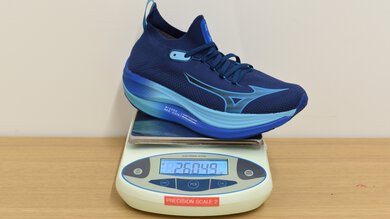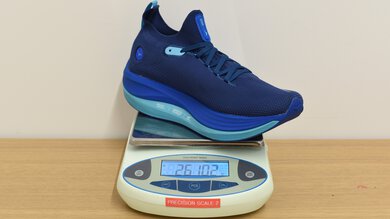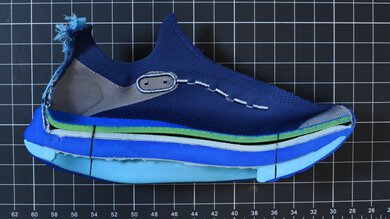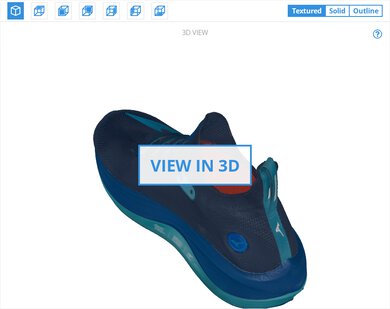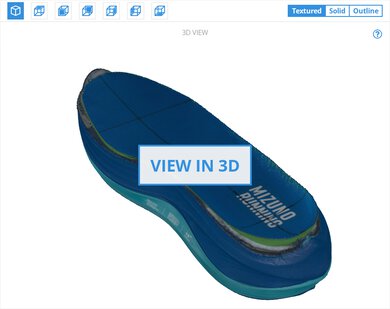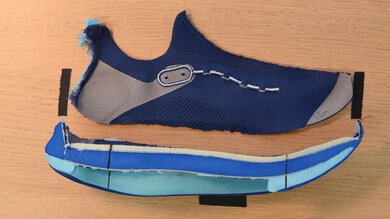The Mizuno Neo Vista delivers a mega-cushioned, enjoyable experience for daily sessions. Featuring a knit upper and a dual layer of soft EVA foam separated by a nylon plate, this shoe offers a comfy feel meant for recovery runs and those in between training days. The inclusion of a nylon plate to stabilize the soft foam and an aggressive rocker profile position this shoe in the max-cushioned super trainer category.
Our Verdict
The Mizuno Neo Vista is decent for marathon racing. It provides excellent cushioning and very good lateral stability, which is beneficial for long runs where comfort and foot protection matter. However, it suffers from mediocre energy return and an average weight profile, which could limit efficiency over extended distances, making it less ideal for competitive marathoners looking for optimal responsiveness and speed.
-
Great cushioning for long distance.
-
Decent stability.
-
Full nylon plate adds stiffness.
-
Heavy.
For shorter races such as 5K and 10K, the Mizuno Neo Vista is not bad. Despite the shoe's plate design adding stiffness, the disappointing energy return and relatively soft foam hold back its ability to deliver explosive speed, potentially limiting runners seeking a more aggressive, fast-paced racing experience.
-
Full nylon plate adds stiffness.
-
Heavy.
The Mizuno Neo Vista offers disappointing energy return, making it underwhelming for runners prioritizing a springy, responsive feel. This means the shoe won’t actively propel you forward, making it a weak choice for those who want energetic strides and lively runs.
-
Energy return is lacking.
The Mizuno Neo Vista impresses with amazing cushioning. Both heel and forefoot cushioning are excellent, providing plush and consistent protection. This significantly reduces fatigue, making it a particularly good option for daily mileage where foot protection and recovery matters most.
-
Amazing cushioning.
-
Ultra-high stack makes for a protective midsole.
Lateral stability is decent in the Mizuno Neo Vista, thanks to its super wide base, ensuring a remarkably stable platform. Although the foam is notably soft, creating more lateral movements, the overall stability is solid enough to support runners effectively, especially when maintaining efficient form becomes challenging.
-
Full nylon plate adds stiffness.
-
Very wide base.
-
Stack height means you're high off the ground.
-
Foam is overly soft, especially in the heel.
- 6.4 Marathon Racing
- 6.3 5K/10K Racing
Performance Usages
- 4.7 Energy Return
- 8.7 Cushioning
- 7.0 Lateral Stability
Changelog
- Updated Apr 02, 2025: Converted to Test Bench 0.8.
- Updated Apr 02, 2025: Review published.
Check Price
Differences Between Sizes And Variants
We tested the Mizuno Neo Vista in men's US size 9, as indicated on the label. The color featured here is Estate Blue/River Blue. This model is also available in Plein Air/River Blue, Citadel/Bay, and Nimbys Cloud/Vintage Indigo. Wide versions are not offered for this shoe.
Compared To Other Running Shoes
The Mizuno Neo Vista is a standout super trainer, prioritizing cushioning over responsiveness or weight. Its distinctive combination of a high stack height and a plastic plate gives it some versatility for different types of runs, but it truly shines during easy sessions. Compared to other plated super trainers like the HOKA Mach X 2, the Neo Vista offers similarly generous cushioning, yet it's less versatile for faster workouts due to a less responsive midsole and heavier build. Runners seeking plushness without the distinct suction cup and plated feel of the Neo Vista might still prefer dedicated max-cushioned options like the Brooks Glycerin Max.
Within Mizuno's own lineup, the Mizuno Neo Zen offers even more cushioning and responsiveness and is significantly lighter. The Zen is a newer, better version of the Neo Vista. Ultimately, the Neo Vista is still a good choice for runners who value comfort for their recovery sessions.
For more options, check out our recommendations for the best running shoes to find the perfect pair.
The Mizuno Neo Vista and the Mizuno Neo Zen may look similar at first glance, but they deliver very different experiences underfoot. The Neo Vista includes Mizuno's signature Wave Plate, which adds some structure but ultimately makes the ride feel sluggish and out of place for a shoe trying to act like a super trainer. Its large midsole cutout also gives it a somewhat suction cup-like feel. In contrast, the Neo Zen removes the plate entirely, allowing the soft foam to move more freely and deliver a significantly more cushioned and natural ride. It's also notably lighter, which helps it feel more nimble and efficient on foot. While both are well-suited for easy or recovery runs, the Neo Zen improves on nearly every aspect, making it a smoother and more refined option for daily mileage.
The Saucony Endorphin Speed 4 and the Mizuno Neo Vista are both plated trainers but excel in different areas. The Saucony is a lighter, more responsive super trainer, better suited for picking up the pace and racing shorter distances, making it a great option for workouts, intervals, or even competitive events. The Mizuno, on the other hand, is a plated premium trainer that provides a more cushioned, comfortable experience with greater protection, which is ideal for runners seeking plushness on recovery runs.
The Brooks Glycerin Max and the Mizuno Neo Vista are both highly cushioned, high-stack premium trainers but cater to slightly different needs. The Neo Vista, positioned as a plated trainer, offers a noticeably more energetic and bouncy ride—though not the most responsive compared to some plated options. In contrast, the Glycerin Max focuses uniquely on comfort, delivering plush cushioning ideal for easy-paced or recovery runs.
The HOKA Mach X 2 and the Mizuno Neo Vista are both versatile, plastic-plated trainers designed to blend cushioning and performance, but each has distinct strengths. The Mach X 2 stands out as a super trainer for being even more cushioned, lighter, and more responsive, giving it greater versatility across various workouts and paces—from daily runs to faster efforts. The Neo Vista, while heavier and less energetic, still excels as a protective, comfortable option, particularly suited for recovery miles where leg preservation is key, putting it more in the plated premium trainer category.
Test Results
The Mizuno Neo Vista leans towards the heavier side. It isn't notably lightweight, meaning competitive runners might find it less ideal where speed and agility matter most. That said, it's way lighter than similar plated max-cushioned options like the HOKA Skyward X. For daily training or slower-paced runs, its moderate weight won't pose significant drawbacks, but for serious racing scenarios, this shoe falls short of being notably efficient.
The heel energy return in the Mizuno Neo Vista is inadequate, delivering only limited responsiveness upon impact. This moderate performance means the shoe won't provide a notably springy or energetic sensation in the heel area, which may disappoint runners who prefer a more lively and responsive ride.
The forefoot energy return is disappointing, resulting in a dull, sluggish feel during push-offs. Its low responsiveness limits the shoe's performance for runners who seek explosive strides and energetic propulsion, making it a poor option for speed workouts or competitive racing situations.
The heel cushioning is amazing, delivering a notably plush sensation underfoot. However, the unique underfoot design, characterized by a large cutout in the middle of the outsole, can create a slightly suction-cup-like feel upon impact. The foam compresses effectively, which runners who favor maximal cushioning will greatly appreciate. However, this plushness might feel overly cushioned for those seeking a more balanced experience.
The forefoot cushioning is also excellent, providing soft yet supportive protection that efficiently absorbs impacts. This makes the Mizuno Neo Vista a strong choice for runners who prioritize comfort and protection.
The heel of the Mizuno Neo Vista is overly soft. This can significantly detract from stability at higher impacts. While the plush cushioning might enhance comfort, the compromised firmness diminishes stability during intense runs, making the shoe less effective for runners needing solid support for consistent foot placement.
There's still some softness to the foam in the forefoot, but it's firmer than the heel. This could appeal to runners looking for a balanced forefoot feel that supports stability during regular runs but might lack sufficient firmness when pushed to higher forces.
Check Price
Comments
Mizuno Neo Vista: Main Discussion
Let us know why you want us to review the product here, or encourage others to vote for this product.
This product has been merged with Mizuno Unisex Neo Vista Running Shoe, Ignition Red-B. Follow the discussion here.


